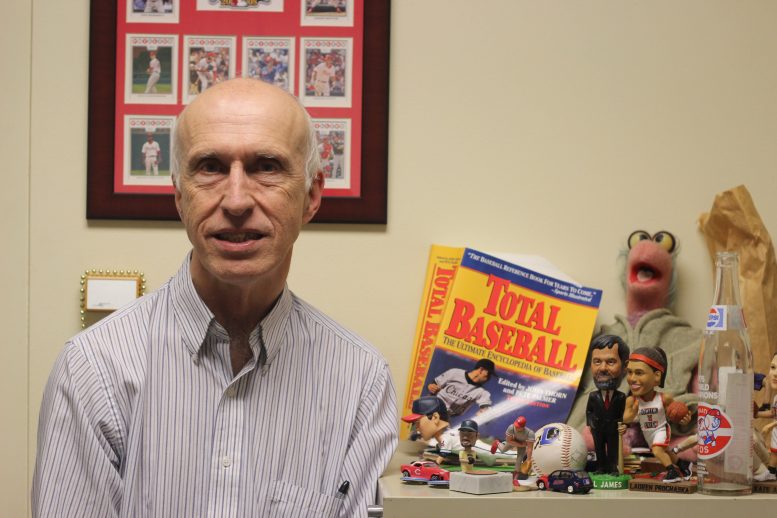By DAVID DUPONT
BG Independent News
Life is becoming more like baseball, at least when it comes to numbers.
“This is really the best time to be a statistician,” said Jim Albert, of the Bowling Green State University faculty. “Data is so much a part of our lives. It’s affecting every part of our lives,” just like baseball, the most statistically dense sports, and Albert’s passion.
The book he wrote with Jay Bennett “Curve Ball: Baseball, Statistics, and the Role of Chance in the Game” is baseball by the numbers. It applies advanced statistical metrics to all aspects of the game.
In February the university board of trustees named Albert a Distinguished University Professor. Trustee James Bailey said the university is lucky some major league team hasn’t snapped Albert up as a team statistician.
Albert’s love of baseball goes back to his upbringing in Philadelphia. He is a Phillies fan. He played youth baseball, but concedes he wasn’t good. His game is tennis.
“I grew up on baseball and collected baseball cards and playing baseball simulation gams like Strat-O-Matic,” he said.
He had an aptitude for numbers. He was on the math club in high school and took part in math competitions.
Decades later he devoted the first chapter of “Curve Ball” to the various statistical models used by baseball simulation games.
With a natural inclination toward numbers, Albert went on to study mathematics at Bucknell University and then earned his graduate degrees from Purdue. BGSU wasn’t really much on his radar. That statistics was lumped in with math was a bit of a concern. Statistics usually does better in an area like business, sociology, or medicine “because they need that application.”
Still he took the job in 1979, and has stayed ever since. His wife, Anne Albert, was hired to teach mathematics at the University of Findlay. “We were hired and got tenure at the same time,” he said. She retired two years ago.
So the decision to stay was easy. Also, Albert has an interest in education, so being at a university with a strong education program was attractive.
And baseball and sports can be a useful way to hook students on statistics, he said. He’s written a textbook “Teaching Statistics Using Baseball.”
At Purdue he studied with some of the leading lights of Bayesian economics. Unlike classic economics which focuses on frequency, Bayesian economics focuses on probability, and adjusting one’s hypothesis as more data is considered.
It requires complicated computational models that became far more feasible with the advent of computer technology.
Baseball would often serve as example of their methods. Take, for example, the concept of reversion to the mean. Batting averages are an example of that. Early in the season, averages can fluctuate wildly. A journeyman player could be hitting the cover off the ball, while a star seems mired in a slump. As the season progresses, though, these outliers tend to dissipate, and batting averages settle in about where a fan would expect.
Batting shows this more that pitching, Albert said.
Hitting involves more luck than pitching. After all, a batter can look bad on a couple pitches and still end up getting a hit. A pitcher looks bad on one pitch, and the ball is gone. Pitching, he said, relies much more on skill.
Of particular interest for Albert is the idea of streaks and clutch performers, both issues he explores in “Curve Ball.”
He disputes with numbers the notion that some players particularly excel in clutch situations. Even if retired Yankees star Derek Jeter laughs at him for saying it, Albert debunks the notion. “He didn’t have any special ability to do better in clutch situations. He was just a better player.”
Baseball was the first sport to pay attention to statistics. Box scores appeared more than a century ago. Being a game made up of a series of discrete events, it lends itself better to such analysis than other sports.
Statistics has embedded itself into the sport from the fan to the broadcast booth to the front office, where a number of Albert’s colleagues have ended up.
And baseball statistics continue to proliferate. Statcast represents the newest development. The system measures every split second of every player’s performance. Never mind batting average or slugging percentage, Statcast can measure how fast the ball leaves the bat, the arch it takes when hit, and the degree it is pulled to one field or another. “We’re learning more about what it takes it to get a base hit,” Albert said. “It‘s fascinating because we’re learning more about the game. To me the fact that there’s all this data in baseball is a gold mine.”
But Albert doesn’t only study baseball. He’s collaborated with Jon Sprague, director of the Center for the Future of Forensic Science. Albert was a co-author on a recently published major paper dealing with the analysis of sexual assault kits.
Statistical analysis of crime data “is in the dark ages,” he said. “They can do so much more.”
Fingerprint evidence is still based on the testimony of an individual expert witness. But Albert wonders: “How does a person make that decision? Why don’t we look carefully and quantify it? We can do a statistical analysis to make that decision. Why do we have to rely on people to make these statements?”
It is issues like this that make the question of when he’ll retire difficult for the 64-year-old Albert to answer. “I have to figure out what retirement looks like.”
Then he starts talking about data mining and writing a textbook to bring Bayesian statistics to the undergraduate level.
“I enjoy what I do,” he said. “I enjoy working with students. … I can do research in baseball. It must be a great world. It’s remarkable that I can do things that are very enjoyable, rewarding, and fun.”

